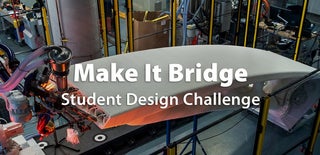Introduction: Fusion 360 Hydroponics Bridge Design
Hi! My name is Newton Zheng, and this is my entry for the 2023 Make It Bridge contest. I am in 8th grade, 14 years old, and will be going into high school next year. I already have quite a bit of experience in the 3D modeling and manufacturing fields. My entry for this contest is a 1:144 scale bridge that grows trees using water from the river that the bridge is over. Keep in mind that this bridge is only made to be used over a body of water, so it would not function if it is bridging over a valley. Whenever we water plants, most of that water goes straight into the ground and evaporates, which is bad in states like California where there is a drought problem. My design will try to maximize efficiency when it comes to watering trees. My design will make use of pumps to bring water to trees and then cycle the unused water back into the river, preventing any loss of water. The design itself only spans around 40 meters, but multiple copies of it can be put together to form a longer bridge that can cross larger bodies of water.
Supplies
Tools/Materials used for this project:
- Fusion 360(used for designing the bridge)
- Ender 3 S1 Plus(used for printing prototype)
- Overture Gray PLA+(used for printing prototype)
- Starbond CA glue(used to assemble prototype)
Step 1: Brainstorming
I first needed an idea in order to make the design itself. I thought of some recent projects that I was working on, and I thought that it would be a cool idea to incorporate my aquaponics fish tank design into this bridge. The first thing that I did after my idea was to search whether my idea had ever been done before, and to the extent of my knowledge, no one has ever come up with this idea before.
Step 2: Design of Bridge
"Bridge Forms." Encyclopædia Britannica, www.britannica.com/technology/
bridge-engineering#/media/1/79272/149100. Accessed 17 May 2023.
I decided to do some research about bridge designs and went with the arch bridge, a tried and true method of making bridge supports. I wanted the bridge to have both a lane for cars and a sidewalk for pedestrians. I ended up with an elevated platform for pedestrians with a car lane that runs between the two sidewalks. The sidewalks also have railings to stop anyone from accidentally falling into the surrounding body of water or into oncoming traffic.
Step 3: 3D Modeling in Fusion 360
I first went into Fusion 360 and modeled my design. In the video that I uploaded of my design timeline, you can see that I first used small pot-like vases to plant the trees. I did some further research, however, and I decided to make the containers into a large rectangular design in order to accommodate the size of tree roots. Essentially, my design is an elevated platform for pedestrians with the trees being planted under the walkways with a hole large enough for the trees to grow through. My thought was that some smaller trees could be used, such as a bay laurel, which is used in some compact gardens and is native to California. I have designed pipes running throughout the model to give water to the plants. In order to assure that the water gets to all of the plants, the tree containers are designed with overflow holes so that the water evenly spreads to all of the trees and drains back into the river via the holes on the side of the tree container. After the water leaves the containers, it gets dumped onto a conduit that then carries the water gently back into the river without spilling any on the river below, which was a huge design flaw with my first iteration.
Step 4: Manufacturing of Design
To make a physical model of this prototype, I used a 3D printer to manufacture the design that I created. I first needed to separate the parts of the bridge into printable sections. If you didn't already know, 3D printers layer molten plastic one layer after another in order to create a functional model. Some parts are impossible to print because the printer is not capable of layering the molten plastic in that shape. Therefore, I needed to separate the individual sections of the bridge to make everything able to print. The total print time took me a few days, but everything printed well with the exception of a few layer shifts.
Step 5: Assembly
Assembly of the parts was really easy. All I had to do was take some CA glue and glue together the models. For the drainage pipes, I used a 1.75 mm 3D printing filament, which I happened to have on hand and was a great representation of water pipes. Attached to this step is a video showing my assembly process. It is sped up, so it is a little fast. The image that is uploaded shows all of the tools and the parts that I used during the assembly.
Step 6: Finished Product
Step 7: Conclusion
Overall, I had a ton of fun designing this bridge. I got to showcase many of my skills, especially in the 3d modeling and printing industries. I also gained a lot of experience in designing functional and good-looking models, which was one of my shortcomings before this. I really enjoyed participating in this competition, and I hope to participate in more in the future.

Participated in the
Make It Bridge















